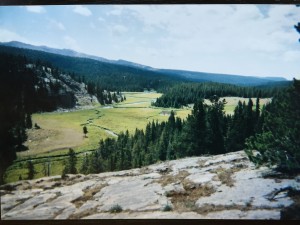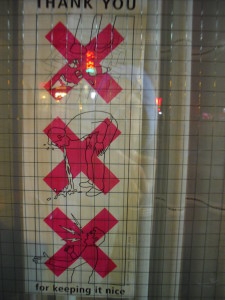Many Amsterdam residents worry about people going through their garbage, but it’s not identity thieves they fear.
It’s “3 guys with handcuffs on their belts” who have legal authority to rip open your trash, dump it onto their truck bed, and search for identifying information — receipts, envelopes, bank statements, etc.
It’s the police. The rubbish police.
What are they going to do?
Fine you, of course. Probably 100€. 1$110 USD – June 2015 Why? Garbage out at the wrong time? Failed to drop your bag *into* the underground collection bin? Didn’t separate your glass, plastic, and paper from unrecyclable items?
In a city famous for loose drug and prostitution laws, breaking rubbish rules is serious business. Not surprising when you realize the country is so land-poor that almost everyone lives in drained lake beds.
Sardine Scene
For now I’ll spare all the non-nerds the fascinating descriptions of this lake draining business. Suffice to say, territory is scarce. Guidebooks like Lonely Planet claim the closeness forced by lack of space causes the Dutch to be curious about each other’s lives. They are fairly open to sharing as well, since there’s really no place to hide. To one local, whose childhood took place outside the Netherlands, it seems like a persistent and rude invasion of privacy.

Why are the buildings lining the Damrak Canal the most photographed in Amsterdam? It’s one of few places you can get far enough away from the buildings to take a picture. So, contrary to appearance, Amsterdam isn’t generally like venice with edifices right on the water. NB: This also happens to be right across from the Sex Museum where I learned that kink and sex really haven’t changed all that much in the last hundred and fifty years.
The packed-in feeling in land-poor Holland is emphasized in Amsterdam’s center. Iconic houses built four centuries ago lean precariously on each other like a bunch of drunks. 2Apparently the tall, skinny houses are thanks to a 1600s policy of taxing buildings by the width of their frontage. Further afield, I repeatedly observed people having what I consider “vignette” experiences of life, thanks to a lack of space. Examples:
- In a community garden divided into blocks the size of a bedroom, many of the tiny veggie patches had a chair or two nestled in between broccoli and tomato plants. Presumably garden owners sit and bask in the public, non-descript setting alongside the freeway.
- On a residential street, I watched a man teach his toddler to ride a push toy. The only available, safe, open space was the footpath leading up to their front door — an area smaller than your average sofa footprint.
- On a Sunday, I looked out the train window and saw a group of maybe 20 people gathered around a pond in a field. It had less water than a backyard pool. Yet, they sat in lawn chairs, drinking beers, picnic blankets spread on the ground just like it was a big day out at the local reservoir.
To me, these scenes look like just that — scenes. Slices of make-believe. Like actors waiting for camera crews to come capture the action from an angle that transforms lesser-reality into ideal illusion. I felt like I was watching the filming of a T.V. show. The characters are less real when you can see their living rooms don’t have a ceiling or a fourth wall.
The Problem with Plentitude

Favorite lake of my youth – taken with the disposable cameras of my youth. I can count on one hand the number of times I’ve seen another person on this trail.
I recognize that my Dutch experience likely falls on the extreme end of the spectrum. The world’s average population density is 120 people per square mile. Where I’m from, the number falls to 6, and in the Netherlands, it rises to 1,000. 3The top five countries in the world are between 11,000 and 50,000 people per square mile, so the Netherlands doesn’t have it all that bad. I felt both spoiled and ruined. After a lifetime of regular access to the richness of 100% solitude and silence, I may never be able to derive deep joy from sitting in a chair under a lilac bush facing a public path with a freeway and its noise just over my shoulder.
I repeatedly turned a philosophical question over in my mind as I traversed the streets and countryside. Which is better:
- having a great love 4e.g. the open spaces of my youth that takes one to the limits of human experience, but after which all other experiences pale in comparison
- never knowing the deepest love possible, but being (blissfully?) unaware of the relative mediocrity of one’s experiences
Or, perhaps there is a number three, which is that “We see things not as they are, but as we are.” Meaning each person’s experience in singular and incomparable?
And does the necessity to focus on micro-experience raise one’s awareness about the importance of shared resources and space? Does it reduce individualism and entitlement?
Okay, to any philosophy nerds that are still with me, out of politeness, we shall abandon this “boring” topic in exchange for more entertaining anecdotes and observations.
Amsterdam Made Me Go, “Whoa!”
Things that fascinated me in the capital of the Netherlands:
-

Yucky… yet practical. Apparently Amsterdam urinals are also well known for having flies in them? Helps improve aim, supposedly. photo: y610adaw
Street Urinals — to the ignorant eye, these look a bit like open-air phone booths. Shaped sort of like a comma, you enter at the tail, walk to the center, do your business, and walk out. When I finally saw someone using one for its intended purpose, I flashed back to the only one I’d ever seen”¦ being used by animated mannequins for a very different purpose at the Amsterdam sex museum. GROSS!
- XXX, not just for sex — I wasn’t surprised to see triple x’s gracing storefronts in one of the world’s top ten sin cities. But then I saw them on a municipal garbage truck. And then on a poster encouraging viewers not to litter, vomit, or yell. Huh? Turns out Amersterdam’s XXX’s have nothing to do with the porn industry’s triple X. They are a 500 year-old part of Amsterdam’s identity – St. Andrew’s Crosses on the city’s coat of arms.
- Pay to Pee — women, break out your wallets! While men have the cost-free option of public urinals, establishment toilets often aren’t complimentary. A bar I visited advertised a bathroom deal — 2.50€ for unlimited access. Otherwise, it’s .50€ per visit. I’m told it’s the same (or more $!) in clubs. In a way, it was handy to be able to pop into any McDonald’s, coin in hand, and beeline for the bathrooms without guilt for not buying any grub. But it seems to me men are basically encouraged to pee in public.
- Bikes, but Not Pumps — on the way to a funky artist’s work-village 5With incredibly affordable workspace! Made from retired houseboats connected by boardwalks!, I realized my borrowed bike needed some air in the tires. In a place where 800,000 people use their bikes daily, one might expect to find public airing stations. One would be disappointed. We finally found some squatters gathered on dilapidated couches outside a vacant storefront. They handed over their pump and watched with amusement as I racked my brain for latent Presta-valve knowledge.
-
Pedaling in the Past — You may be surprised to learn, in a country known for cycling, their bikes kind of suck. And they don’t wear helmets. I saw an entire family on a bike – just like Bolivia. Toddler in a seat strapped on the handlebars, kid standing on the pannier rack in back, and Dad at the helm looking like he just stepped off a 90’s grunge album cover. 6stocking cap, toms (shoes), baggy, rolled up jeans – awesome! No helmets, of course. Most people ride something translated as “granny bike,” which is heavy, has only a single gear, and has brakes that are engaged by pedaling backward. Supposedly, the bike market is slowly being modernized. In the meantime, you can still enjoy the silly spectacle of someone trying to pedal a single-gear bike up and over a bridge.
- Water Aficionados — speaking of bridges, there are many. Canals abound in this land of drained lakebeds. On a gorgeous springtime weekend, residents and tourists alike piled onto watercraft with picnics and beverages. Dutch flags flew out the back of every sun drenched boat where passengers reclined. Once again, when contrasted with my childhood on huge lakes in relative solitude, motoring in stone canals surrounding by houses seemed like a vignette experience to me. The smiles were genuine, though, that’s for sure.
- Floating Future? — The Dutch bring new meaning to “lake house.” Out the train window one day I saw typical houses built on floating platforms anchored along the edge of a large pond. Who needs land when you’ve got buoyancy and plenty of water?
- Springtime Snowbanks — for weeks seeds float down from trees like dime-size confetti that coats lawns and paths, building up into “snowbanks.” Surreal!
- Late-evening Sunshine — it was disorienting to look out the window near bedtime. At 9 p.m. the brightly lit landscape was a sharp contrast to the memories still fresh in my mind of dark evenings in almost-wintertime Australia. This is my second spring in a row in Europe, but the late-night light still gets me every time. In a good way.
-

Basically a larger-than-life, hot vending machine – Febo is where one can go after munchie-inducing activities at “coffeeshops.”
Market for Mary Jane — I’d be remiss not to mention the “coffeeshops” tucked down many streets where it is perfectly legal to buy marijuana, hash, and edibles. From memory 7i.e. you should look up the details if they matter to you, a few years ago there was a political push to clean up Amsterdam’s reputation. New legislation banned non-residents from purchasing the soft drugs on offer at “coffeeshops.” The result: nothing but the loss of tourism dollars and outrage of hotel owners and myriad businesses who suddenly lost associated revenue. During my May 2015 visit, we had no problem making purchases.
That’s all for now! Stay tuned to find out why I (thought I) got called a bitch at a European music festival and how the Dutch came to live in a giant, cold, windswept swamp. ♣
See the Dutch name for Cool Ranch Doritos, a headshop attached to a historic church, and myriad sin-city antics in this facebook album.
References
| ↑1 | $110 USD – June 2015 |
|---|---|
| ↑2 | Apparently the tall, skinny houses are thanks to a 1600s policy of taxing buildings by the width of their frontage. |
| ↑3 | The top five countries in the world are between 11,000 and 50,000 people per square mile, so the Netherlands doesn’t have it all that bad. |
| ↑4 | e.g. the open spaces of my youth |
| ↑5 | With incredibly affordable workspace! Made from retired houseboats connected by boardwalks! |
| ↑6 | stocking cap, toms (shoes), baggy, rolled up jeans – awesome! |
| ↑7 | i.e. you should look up the details if they matter to you |






2 pings